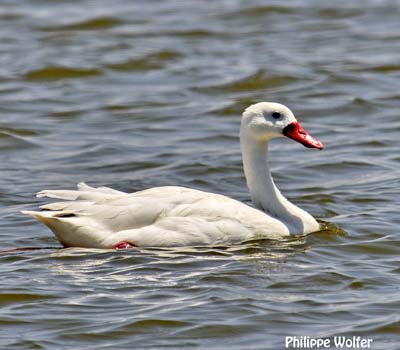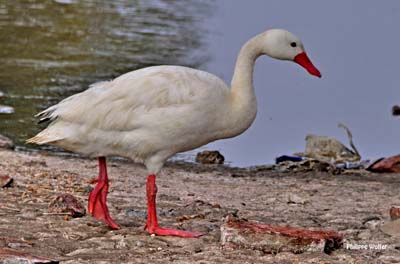
Coscoroba Swan
Coscoroba coscoroba
Anseriforme Order – Anatidae Family
BIOMETRICS:
Length: 90-115 cm
Wingspan: 155-157 cm
Weight: M : 4600 g – F : 3800 g
LONGEVITY: Between 20 and 36 years in captivity.
DESCRIPTION:
The Coscoroba Swan is the smallest swan. According to some other opinions about the classification, this species would be most closely related to whistling-ducks. But most of opinions give it as a true swan resembling goose!
Fr: Coscoroba blanc
All : Coscorobaschwan
Esp : Cisne Coscoroba
Ital: Cigno coscoroba
Nd: Coscoroba-gans
Russe: Коскороба
Port: Capororoca
Photographers:
Philippe Wolfer
OISEAUX D’ARGENTINE
Eduardo Andrés Jordan
MIS AVES – AVES DE ARGENTINA
Text by Nicole Bouglouan
Sources:
HANDBOOK OF THE BIRDS OF THE WORLD vol 1 by Josep del Hoyo-Andrew Elliot-Jordi Sargatal - Lynx Edicions - ISBN: 8487334105
GUIDE DES CANARDS, DES OIES ET DES CYGNES – de Steve Madge - Delachaux et Niestlé - ISBN: 2603013769
BirdLife International (BirdLife International)
ANIMALS – Explore, discover, connect
Wikipedia (Wikipedia, The Free Encyclopedia)

The Coscoroba Swan adult has white plumage overall, except black tips to six outer primaries.
Bill is red with pale pink nail. Eyes are yellowish to reddish-orange. Legs and webbed feet are bright pink.
Both sexes are similar, with male larger than female. She may have darker eyes.
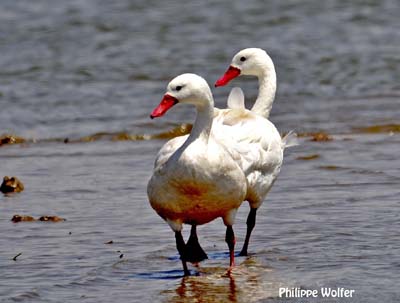
Juvenile is whitish with some greyish areas on crown, back and wings. Bill is blue-grey with white nail. Legs and feet are blue-grey. Eyes are dark brown. It reaches its sexual maturity at about three years.
Chicks are similar to young ducks, with dark brown patches on creamy-white down.
VOICE: SOUNDS BY XENO-CANTO
The Coscoroba Swan’s name comes from the loud, ringing “cos-cor-ooo” call with longer and higher-pitched first syllable.
Female utters higher-pitched calls than male.
The Coscoroba Swan has a honking voice.
HABITAT:
The Coscoroba Swan frequents wet areas such as lagoons and freshwater marshes with vegetated shores.
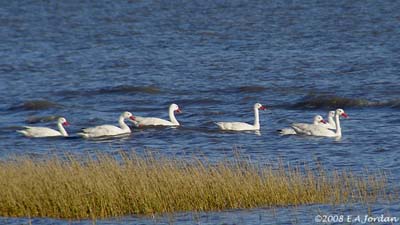
RANGE:
The Coscoroba Swan is a South American species, living from Tierra del Fuego to C Chile and N Argentina.
This species winters in South-eastern Brazil.
BEHAVIOUR:
The Coscoroba Swan feeds as all Anatidae, taking plant matter, aquatic invertebrates and small fish. It forages in shallow water, and may swim or wade. It also grazes on the ground.

As ducks and flamingos, the Coscoroba Swan feeds by combination of water and aquatic items in the bill. Then, it squirts the water out through the lamellae situated on each side of the bill and only keeps the food items.
It feeds by walking and thanks to its fairly long legs, it takes off more easily than other swans, and it does not run to take flight.
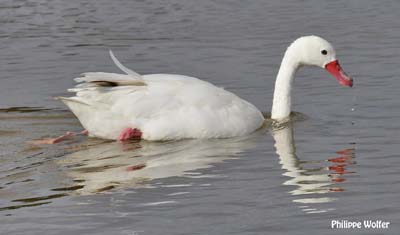
The Coscoroba Swan’s threat displays are similar to swans’ displays. It lifts its folded wings to make them larger, and also performs wing-flapping.
The male may attack a potential rival, before to return to its mate and perform an elaborate ceremony while calling. The male stretches out its wings and performs a kind of “dance”, and both mates call to each other.
The Coscoroba Swan is usually sedentary in its range, except the southern breeders which migrate to lower latitudes, until Tropic of Capricorn.
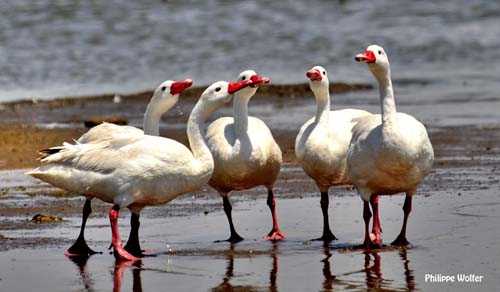
FLIGHT:
The Coscoroba Swan flies very well thanks to its large wings. We can see the black tips of primaries when in flight. It performs mainly wing-flapping, and does not soar or glide.
REPRODUCTION:
Breeding season occurs in spring according to the range.
The Coscoroba Swan mates for life, and usually nests solitary on small islands, in reedbeds or among tall grasses, always close to water.
The nest is a large mound of aquatic plants. The interior is lined with softer materials such as grasses and down.
Female lays 4 to 7 eggs. Incubation lasts about 28 to 35 days by female alone, while the male protects the nest-site.
The downy chicks are able to swim and feed themselves very soon after hatching. Adults defend them against predators and intruders.

DIET:
The Coscoroba Swan feeds on grass and aquatic plants, mussels and small fish taken in shallow water.
PROTECTION / THREATS / STATUS:
The Coscoroba Swan is locally common and still widespread. This species is threatened by habitat loss in some parts of the range, and the chicks are preyed upon by raptors and gulls.
However, the species is not threatened at this moment.
